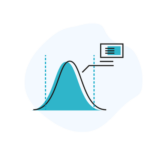
Data analysis
courses, stats

Duration 14 Hours

250 excluding VAT / person
Online training course have higher drop-out rates, so why do ours keep learners engaged and have a success rate of 90% ? The answer ? Our course content !
Kayla is a Green Belt at the B&B plant in Baumé, and has to face real problems on the job. You need to help her find the solutions.
Still need more support? We offer tutoring sessions with our Master Black Belts trainers to support you!
Analyze data
Data analysis training is lively and interactive. The resources provided will enable you to master the subject perfectly.
Program
Descriptive statistics, Graphs
- Identify the benefits of graphical representation
- Quantitative variables
- Qualitative variables
- Mixed quantitative/qualitative case
Descriptive statistics, discrete laws
- Probability basics
- Binomial distribution, Hypergeometric distribution and Poisson distribution
- Single sampling control
Descriptive statistics, continuous laws
- Origin of Gauss's law
- The parameters of a Gaussian distribution
- Validate the normality hypothesis
- Testing for outliers
- Student's law
- Normality analysis Skewness and Kurtosis
- Law of distribution of averages and confidence interval
- Law of variance distribution and confidence interval
Inferential Statistics
- Hypothesis testing
- Alpha and beta risks
- Test power
Frequency comparison
- Various tests
- Compare a frequency with a theoretical frequency (1P)
- Comparing two frequencies (2P)
- Compare more than two frequencies (independence table)
Comparison of averages
- Compare an Average to a theoretical Average (z and theoretical t)
- Compare two Averages (t)
- Compare more than two averages (ANAVAR)
- Dissociating matched cases
Variance comparison
- Comparing a Variance to a Theoretical Variance
- Comparing two Variances
- Compare more than two Variances
Non-parametric tests
- Understanding the benefits of non-parametric tests
- Principle of the main non-parametric tests
- Simple examples of non-parametric tests (signs and B to C)
- Application to sensory measurement
- Theoretical and matched comparison: Wilcoxon test
- Comparison of two populations: Mann Whitney test
- Comparison of more than two populations Krustal-Wallis, Mood, Friedman, Page test
Simple regression
- Principles and calculations
- Hypothesis testing of coefficients
- R² interpretation
- Non-linear regression
Multiple regression
- Principles, calculations and interpretation
- The benefits of multiple regression
- Non-linear responses
- Qualitative factors
Objectives
- Prove the validity of a hypothesis with a statistical test and interpret the result.
- Understand the use of descriptive and inferential statistics.
- Know how to use the right statistical test.
- Understand the difference between simple regression and multiple regression (linear and non-linear).
For whom
This e-learning course on data analysis is designed for engineers, supervisors or technicians who have production or test results to interpret, or who are looking for cause-and-effect relationships or correlations in a data table.
Prerequisites
- Basic use of the Internet and a web browser.
- Level 4 diploma and/or 2 years' professional experience.
Duration
14 hours of animated 100% e-Learning, certification practice quizzes, implementation of theoretical points on industrial simulators. The e-Learning is available 24/7 for 1 month for this training course.
Accessibility
This training course is accessible to people with disabilities. Please contact us for specific accommodation options. We will do our utmost to accommodate you.
Analyze data
Data analysis training is lively and interactive. The resources provided will enable you to master the subject perfectly.
Your feedback
This training provided me with knowledge and mastery of basic statistical tools, directly applicable to our field of action at work.
EdgarR&D Technician, Groupe SEB
Methodology very accessible to us industrialists, non-scientists: discovery of the inversion test, ergonomics and intuitiveness of the software used (Ellistat) compared to Minitab.
LaurentMaterials Project Manager, Chatelain G&F
A fun, educational training program that inspires teams to get involved and roll out the approach on the shop floor.
PascalHaute Horlogerie workshop manager
The training really takes you into the method, and the Ellistat software is a real plus. The trainer is very knowledgeable and dynamic.
ClémentEngineer / Design Group Manager, Bosch Automotive
I now know how to use the method's tools to solve problems, but also to prove that the actions I've taken are improving the situation.
DenisIndustrialization Engineer, Bosch Automotive
The subject is explored in detail with a logical progression throughout the training, without being drowned in information. You want to apply what you discover and learn.
NathanMethods Engineer, ORANO
No disappointment, quite the opposite in fact, as the course follows a guiding principle. A very refreshing case study of a real industrial problem - a brewery!
VincentQuality Manager, SAINT GOBAIN
Previous
Next




